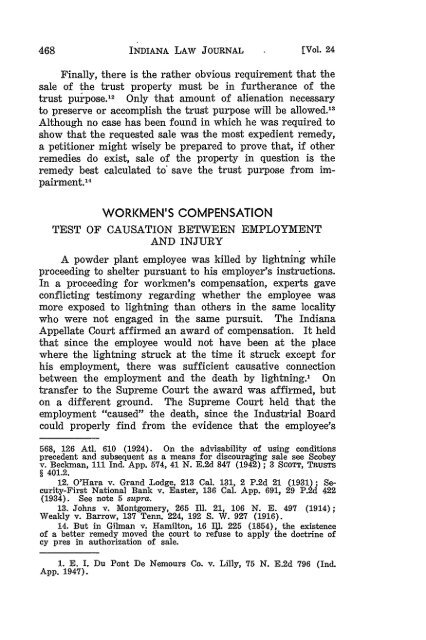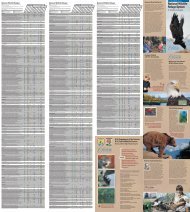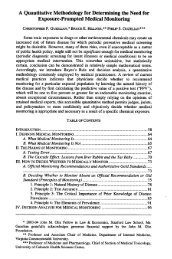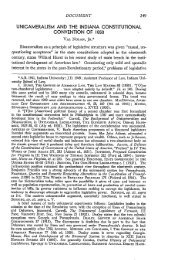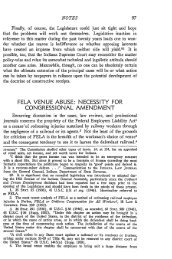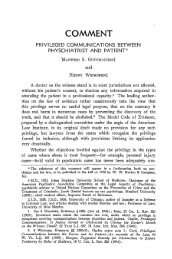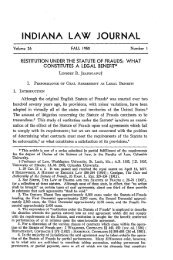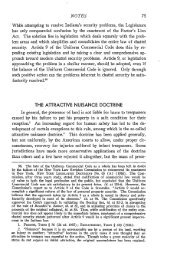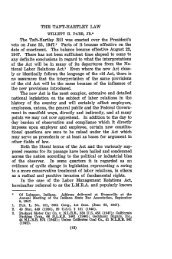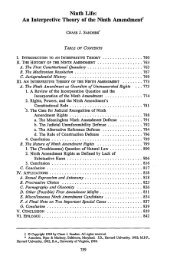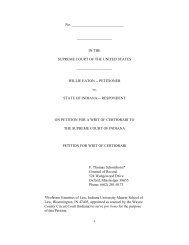Test of Causation Between Employment and Injury - Indiana Law ...
Test of Causation Between Employment and Injury - Indiana Law ...
Test of Causation Between Employment and Injury - Indiana Law ...
Create successful ePaper yourself
Turn your PDF publications into a flip-book with our unique Google optimized e-Paper software.
INDIANA LAW JOURNAL<br />
[Vol. 24<br />
Finally, there is the rather obvious requirement that the<br />
sale <strong>of</strong> the trust property must be in furtherance <strong>of</strong> the<br />
trust purpose. 12 Only that amount <strong>of</strong> alienation necessary<br />
to preserve or accomplish the trust purpose will be allowed.' 3<br />
Although no case has been found in which he was required to<br />
show that the requested sale was the most expedient remedy,<br />
a petitioner might wisely be prepared to prove that, if other<br />
remedies do exist, sale <strong>of</strong> the property in question is the<br />
remedy best calculated to' save the trust purpose from impairment.1<br />
4<br />
WORKMEN'S COMPENSATION<br />
TEST OF CAUSATION BETWEEN EMPLOYMENT<br />
AND INJURY<br />
A powder plant employee was killed by lightning while<br />
proceeding to shelter pursuant to his employer's instructions.<br />
In a proceeding for workmen's compensation, experts gave<br />
conflicting testimony regarding whether the employee was<br />
more exposed to lightning than others in the same locality<br />
who were not engaged in the same pursuit. The <strong>Indiana</strong><br />
Appellate Court affirmed an award <strong>of</strong> compensation. It held<br />
that since the employee would not have been at the place<br />
where the lightning struck at the time it struck except for<br />
his employment, there was sufficient causative connection<br />
between the employment <strong>and</strong> the death by lightning.' On<br />
transfer to the Supreme Court the award was affirmed, but<br />
on a different ground. The Supreme Court held that the<br />
employment "caused" the death, since the Industrial Board<br />
could properly find from the evidence that the employee's<br />
568, 126 Atl. 610 (1924). On the advisability <strong>of</strong> using conditions<br />
precedent <strong>and</strong> subsequent as a means for discouraging sale see Scobey<br />
v. Beckman, 111 Ind. App. 574, 41 N. E.2d 847 (1942); 3 SCOTT, TRUSTS<br />
§ 401.2.<br />
12. O'Hara v. Gr<strong>and</strong> Lodge, 213 Cal. 131, 2 P.2d 21 (1931); Security-First<br />
National Bank v. Easter, 136 Cal. App. 691, 29 P.2d 422<br />
(1934). See note 5 supra.<br />
13. Johns v. Montgomery, 265 Ill. 21, 106 N. E. 497 (1914);<br />
Weakly v. Barrow, 137 Tenn. 224, 192 S. W. 927 (1916).<br />
14. But in Gilman v. Hamilton, 16 Il. 225 (1854), the existence<br />
<strong>of</strong> a better remedy moved the court to refuse to apply the doctrine <strong>of</strong><br />
cy pres in authorization <strong>of</strong> sale.<br />
1. E. I. Du Pont De Nemours Co. v. Lilly, 75 N. E.2d 796 (Ind.<br />
App. 1947).
19491<br />
RECENT CASES<br />
duties exposed him to an increased risk <strong>of</strong> being struck by<br />
lightning. E. I. Du Pont De Nemours Co. v. Lilly, 79 N. E.2d<br />
387 (Ind. 1948).<br />
In a compensation case the claimant must prove that his<br />
injury resulted from an accident arising out <strong>of</strong> <strong>and</strong> occuring<br />
in the course <strong>of</strong> the employment. 2 In most cases <strong>of</strong><br />
injury resulting from an act <strong>of</strong> God, the problem is whether<br />
the injury is one "arising out <strong>of</strong>" the employment within<br />
the meaning <strong>of</strong> the statute. All courts agree that the statutory<br />
words refer to <strong>and</strong> require a causal connection, 3 but<br />
there is no uniformity <strong>of</strong> opinion on the question <strong>of</strong> the precise<br />
.degree <strong>of</strong> causal connection necessary for compensation<br />
rights.<br />
Two general tests in determining sufficiency <strong>of</strong> causal<br />
connection have been developed. Most courts, although using<br />
differing verbal formulations <strong>of</strong> the test, make some sort <strong>of</strong><br />
increased risk a requisite factor to find legal causation. 4 A<br />
few courts have adopted the more lenient causal test advanced<br />
by the <strong>Indiana</strong> Appellate Court in this case. 5 In<br />
such jurisdictions the employee or his dependents need only<br />
show that the employment exposed him to the hazard which<br />
caused injury," or as some courts say, that the employment<br />
2. IND. STAT. ANN. (Burns 1933) § 40-1202: ". . . every employer<br />
<strong>and</strong> every employee . . . shall be presumed to have accepted the provisions<br />
<strong>of</strong> this act .. . for personal injury or death by accident arising<br />
out <strong>of</strong> <strong>and</strong> in the course <strong>of</strong> the employment ...<br />
3. E.g., In re McNicol, 215 Mass. 497, 102 N. E. 697 (1913) from<br />
which the following is frequently quoted: ". . . [an injury] arises 'out<br />
<strong>of</strong>' the employment, when there is apparent to the rational mind upon<br />
consideration <strong>of</strong> the circumstances, a causal connection between the<br />
conditions under which the work is required to be performed <strong>and</strong> the<br />
resulting injury."<br />
4. Some courts purport to determine whether the employee was<br />
subjected to a greater risk than the ordinary person in the vicinity:<br />
Gesmundo v. Bush, 133 Conn. 607, 53 A.2d 392 (1947) (frostbite);<br />
Atlanta v. Parks, 60 Ga. App. 16, 2 S. E.2d 718 (1939) (lightning).<br />
Others pr<strong>of</strong>ess to question whether the employee was subjected to a<br />
greater risk than the public generally: L. W. Dailey Construction Co.<br />
v. Carpenter, 114 Ind. App. 522, 53 N. E.2d 190 (1940) (heatstroke);<br />
Trinity Universal Ins. Co. v. Walker, 203 S. W.2d 308 (Tex. Civ. App.<br />
1947) (heatstroke); Industrial Comm'n v. Laraway, 46 Ohio App. 168,<br />
188 N. E. 297 (1933) (lightning). Still others attempt to decide<br />
whether the employee was subjected to an increased or peculiar danger:<br />
Lickfett v. Jorgenson, 179 Minn. 321, 229 *N. W. 138 (1930) (lightning)<br />
; Many v. Bradford, 266 N. Y. 558, 195 N. E. 199 (1935) (lightning);<br />
Consolidated Pipe Line Co. v. Mahon, 152 Okla. 72, 3 P.2d 844<br />
(1931) (lightning); Nebraska Seed Co. v. Industrial Comm'n, 206<br />
Wis. 199, 239 N. W. 432 (1931) (lightning).<br />
5. See HARPER, LAW OF TORTs 422 (1st ed. 1933).<br />
6. Deziley v. Semet-Solvay Co., 272 App. Div. 985, 72 N. Y. S.<br />
2d 809 (1947) (lightning); Harding Glass Co. v. Albertson, 208 Ark.
INDIANA LAW JOURNAL<br />
[Vol. 24<br />
required him to be at the place where the injury occurred. 7<br />
In such a view, increased risk need not be shown.<br />
The record <strong>of</strong> the <strong>Indiana</strong> Appellate Court follows a<br />
pattern <strong>of</strong> vacillation between the strict <strong>and</strong> the lenient types<br />
<strong>of</strong> causal tests. That court recognized in an early decision<br />
that even though the risk to which an employee was subjected<br />
was no greater than that <strong>of</strong> the others in the locality<br />
there might still be causal connection. 8 In later cases the<br />
court held that the employee must be more exposed than<br />
others in the locality, 9 that the employee must be exposed to<br />
different conditions than those <strong>of</strong> other employees, 10 <strong>and</strong><br />
that the employee must be subjected to a greater hazard than<br />
the general public"l in order to claim compensation. In the<br />
last decade the court has been moving toward the simple<br />
test advanced in the present case, simply that the employment<br />
must have exposed the claimant to the injury for which he<br />
seeks compensation. 12<br />
Since the Supreme Court announced its jurisdiction in<br />
866, 187 S. W.2d 961 (1945) (heat prostration); Hughes v. Trustees<br />
<strong>of</strong> St. Patrick's Cathedral, 245 N. Y. 201, 156 N. E. 665 (1927) (heat<br />
prostration).<br />
7. Aetna Life Insurance Co. v. Industrial Comm'n, 81 Colo. 233,<br />
254 Pac. 995 (1927) (lightning); In re Harraden, 66 Ind. App. 298,<br />
118 N. E. 142 (1917) (street risk).<br />
8. In re Harraden, 66 Ind. App. 298, 118 N. E. 142 (1917).<br />
9. Deckard v. Trustees <strong>of</strong> <strong>Indiana</strong> University, 92 Ind. App. 192,<br />
172 N. E. 547 (1931).<br />
10. Thompson v. Masonic Cemetery Ass'n, 103 Ind. App. 74, 5<br />
N. E.2d 145 (1936).<br />
11. L. W. Dailey Const. Co. v. Carpenter, 114 Ind. App. 522, 53 N.<br />
E.2d 190 (1944); Townsend & Freeman Co. v. Taggart, 81 Ind. App.<br />
610, 144 N. E. 556 (1924).<br />
12. See Broderick Co. v. Flemming, 116 Ind. App. 668, 65 N. E.2d<br />
257 (1946); Burroughs Adding Machine Co. v. Dehn, 110 Ind. App.<br />
483, 39 N. E.2d 499 (1942); Montgomery v. Brown, 109 Ind. App. 95,<br />
27 N. E.2d 884 (1940). It is interesting to note that on April 4, 1949,<br />
in Mishawaka Rubber & Woolen Mfg. Co. v. Walker, 84 N. E.2d 897<br />
(Ind. App. 1949), the Appellate Court speaking through Bowen, J.,<br />
seems to have continued its espousal <strong>of</strong> the simple causation test which<br />
the <strong>Indiana</strong> Supreme Court had rejected. Without citing the instant<br />
case, the court said, "While there is great confusion in the recorded<br />
cases <strong>and</strong> the line <strong>of</strong> demarcation is not too clear when applied to the<br />
facts <strong>of</strong> the particular cases, in determining the question presented<br />
by this appeal, we must consider the general rule that an accidental<br />
death arises out <strong>of</strong> the employment when there exists a causal connection<br />
between it <strong>and</strong> the employment. To be compensable, the employment<br />
must be in some way responsible for the accidental injury,<br />
which was drowning in the instant case, <strong>and</strong>, while the more recent<br />
cases do not hold that an employee's injury by accident in order to be<br />
compensable must arise out <strong>of</strong> the nature <strong>of</strong> the employment, the injury<br />
suffered must be in some way incidental to the employment." Id. at<br />
899. (Italics supplied).
19491<br />
RECENT CASES<br />
worknen's compensation cases in 1940,13 it has not passed on<br />
any cases involving an act <strong>of</strong> God. But the court has been<br />
liberal in its interpretation <strong>of</strong> the compensation laws. 14 It<br />
is therefore surprising that the Supreme Court should repudiate<br />
the lenient test advanced by the lower court <strong>and</strong><br />
adopt the increased risk type test for causation. 1 5 The higher<br />
court attempted to reconcile the conflicting decisions in cases<br />
involving lightning <strong>and</strong> other acts <strong>of</strong> God by stating that<br />
the decisions <strong>of</strong> the Industrial Board have always been upheld<br />
when supported by any probative evidence. The court<br />
decided that any lack <strong>of</strong> consistency may be attributed to<br />
factual variations <strong>and</strong> the inevitable effect <strong>of</strong> sympathy for<br />
injured employees <strong>and</strong> their dependents.16<br />
For two reasons the Supreme Court's reliance on the<br />
increased risk test seems unfortunate. Entirely aside from<br />
the question <strong>of</strong> the intrinsic merit <strong>of</strong> that test, it has been<br />
productive <strong>of</strong> nothing but confusion. Particularly in cases<br />
<strong>of</strong> injury by lightning, where every holding has had its opposite,'1<br />
the difficulty <strong>of</strong> applying the test with certainty is<br />
13. Warren v. <strong>Indiana</strong> Telephone Co., 217 Ind. 93, 26 N. E.2d 399<br />
(1940).<br />
14. See, e.g., Patton Park Inc. v. Anderson, 222 Ind. 448, 53 N.<br />
E.2d 771 (1944), where a compensation award was affirmed despite<br />
objection that the workman was not under the control <strong>and</strong> supervision<br />
<strong>of</strong> the employer's agent. Evidence to the contrary was objected to by<br />
the employer as hearsay, but the court found that there was control<br />
<strong>and</strong> declared that strict rules <strong>of</strong> evidence did not apply to the proceedings<br />
before the Industrial Board, which procedure the statute<br />
provided shall be as summary <strong>and</strong> simple as reasonably possible. And<br />
in Soetje & Arnold, Inc. v. Basney, 218 Ind. 538, 34 N. E.2d 26 (1941),<br />
the court declared that in determining whether the finding <strong>of</strong> the<br />
Board was supported by the evidence, any evidence unfavorable to the<br />
finding must be disregarded <strong>and</strong> only favorable <strong>and</strong> reasonable inferences<br />
therefrom should be considered.<br />
15. The court cited <strong>and</strong> apparently approved Deckard v. Trustees<br />
<strong>of</strong> <strong>Indiana</strong> University, 92 Ind. App. 192, 172 N. E. 547 (1931), a case<br />
overruled by the Appellate Court in this case, <strong>and</strong> Illinois Country<br />
Club, Inc. v. Industrial Comm'n, 387 Ill. 484, 56 N. E.2d 786 (1944),<br />
a case in which the Illinois Court reversed an award for injuries sustained<br />
when a caddy was struck by lightning while st<strong>and</strong>ing under a<br />
tree in wet clothes <strong>and</strong> carrying two bags <strong>of</strong> metal golf clubs.<br />
16. Cf. Wells v. Robinson Const. Co., 52 Idaho 562, 16 P.2d 1059<br />
(1932); Illinois Country Club, Inc. v. Industrial Comm'n, 387 Ill. 484,<br />
56 N. E.2d 786 (1944); Mincey v. Dultmeir Mfg. Co., 223 Iowa 252,<br />
272 N. W. 430 (1937) (which indicate an endeavor to keep the burden<br />
<strong>of</strong>f the employer).<br />
17. A review <strong>of</strong> the lightning cases shows the diversity <strong>of</strong> results<br />
obtained from application <strong>of</strong> the increased risk formula. See Note, 26<br />
MicH. L. REv. 422 (1927); Note, 83 A. L. R. 235 (1933). In one <strong>of</strong><br />
the first American cases <strong>of</strong> injury by lightning, the court held that<br />
a workman who took shelter under a tree was subjected to an increased<br />
risk which established causal connection. State ex rel. People's Coal
apparent. 18<br />
INDIANA LAW JOURNAL<br />
[Vol. 24<br />
& Ice Co. v. District Court, 129 Minn. 502, 153 N. W. 119 (1915). Cf.<br />
De Luca v. Board <strong>of</strong> Park Commissioners, 94 Conn. 7, 107 Atl. 611<br />
(1919). Contra: Deckard v. Trustees <strong>of</strong> <strong>Indiana</strong> University, 92 Ind.<br />
App. 192, 172 N. E. 547 (1931). For occupants <strong>of</strong> buildings <strong>and</strong><br />
tents some courts recognize increased danger: Consolidated Pipe Line<br />
Co. v. Mahon, 152 Okla. 72, 3 P.2d 844 (1931); Nebraska Seed Co. v.<br />
Industrial Commission, 206 Wis. 199, 239 N. W. 432 (1931); Fort<br />
Pierce Growers Ass'n v. Storey, 158 Fla. 192, 29 So.2d 205 (1946).<br />
Contra: Thier v. Widdifield, 210 Mich. 355, 178 N. W. 16 (1920)<br />
(barn); Fuqua v. Department <strong>of</strong> Highways, 292 Ky. 783, 168 S. W.2d<br />
39 (1943) (garage); Griffith v. Cole Bros., 183 Iowa 415, 165 N. W.<br />
577 (1917) (tent). Certain jurisdictions have found increased risk<br />
in lightning cases due to the proximity <strong>of</strong> metal: Hassell Iron Works<br />
Co. v. Industrial Commission, 70 Colo. 386, 201 Pac. 894 (1921) (employee<br />
welding on a steel bridge); Emmerick v. Hanrahan Brick & Ice<br />
Co., 206 App. Div. 580, 201 N. Y. S. 637 (1923) (working near a<br />
steel cable); Sullivan v. Roman Catholic Bishop <strong>of</strong> Helena, 103 Mont.<br />
117, 61 P.2d 838 (1936) (carrying a shovel <strong>and</strong> st<strong>and</strong>ing over a metal<br />
pipe line); Traders & General Ins. Co. v. Pool, 171 S. W.2d 135 (Tex.<br />
Civ. App. 1937) (working near a boiler engine <strong>and</strong> under steel guywires);<br />
Atlanta v. Parks, 60 Ga. App. 16, 2 S. E.2d 718 (1939) (spraying<br />
disinfectant from a steel drum) ; Bauer's Case, 314 Mass. 4, 49 N.<br />
E.2d 118 (1943) (st<strong>and</strong>ing near an iron bed <strong>and</strong> electric wiring);<br />
Truck Insurance Exchange v. Industrial Accident Conm'n, 77 Cal. App.<br />
2d 461, 175 P.2d 884 (1946) (working near an iron pipe). Contra:<br />
Wiggins v. Industrial Accident Board, 54 Mont. 335, 170 Pac. 9 (1918)<br />
(operating a metal road drag); Griffith v. Cole Bros., 183 Iowa 415,<br />
165 N. W. 577 (1917) (st<strong>and</strong>ing near a pile <strong>of</strong> steel); Alizina Const.<br />
Co. v. Industrial Comm'n, 309 Ill. 395, 141 N. E. 191 (1923) (trucking<br />
cement in a truck with steel wheels <strong>and</strong> steel braces); Wells v. Robinson<br />
Const. Co., 52 Idaho 562, 16 P.2d 1059 (1932) (plowing with a<br />
metal plow); Mincey v. Dultmier Mfg. Co., 223 Iowa 252, 272 N. W.<br />
430 (1937) (walking near a metal gate); Felden v. Horton & Coleman,<br />
234 Mo. App. 421, 135 S. W.2d 1115 (1939) (holding a metal wrench);<br />
Illinois Country Club, Inc. v. Industrial Comm'n, 387 Ill. 484, 56 N. E.<br />
2d 786 (1944) (carrying bags <strong>of</strong> golf clubs). Some courts recognize<br />
a greater risk with increased altitude: Truck Insurance Exchange v.<br />
Industrial Accident Comm'n, 77 Cal. App.2d 461, 175 P.2d 884 (1946);<br />
Bauer's Case, 314 Mass. 4, 49 N. E.2d 118 (1943). Contra.: Netherton<br />
v. Lightning Delivery Co., 32 Ariz. 350, 258 Pac. 306 (1927). Formerly,<br />
the courts recognized no additional risk to a workman in the<br />
open. Wiggins v. Industrial Accident Board, 54 Mont. 335, 170 Pac.<br />
9 (1918); Hoenig v. Industrial Comm'n, 159 Wis. 646, 150 N. W. 996<br />
(1915). But more recent decisions have held that any outdoor employment<br />
increases the danger <strong>of</strong> harm from lightning: Many v. Bradford,<br />
266 N. Y. 558, 195 N. E. 199 (1935); Mixon v. Kalman, 133 N.<br />
J. L. 113, 42 A.2d 309 (1945).<br />
18. Some courts stress the necessity for expert testimony to support<br />
a finding <strong>of</strong> increased risk: Hassell Iron Works Co. v. Industrial<br />
Comm'n, 70 Colo. 386, 201 Pac. 894 (1921). Other courts take judicial<br />
notice <strong>of</strong> the increased risk in many instances: De Luca v. Board <strong>of</strong><br />
Park Commissioners, 94 Conn. 7, 107 Ati. 611 (1919); Madura v. City<br />
<strong>of</strong> New York, 387 N. Y. 214, 144 N. E. 505 (1924). Generally, the<br />
finding by the Industrial Board as to the presence or absence <strong>of</strong> increased<br />
risk has been held conclusive: Fort Pierce Growers Ass'n v.<br />
Storey, 158 Fla. 192, 29 So.2d 205 (1946); Fuqua v. Department <strong>of</strong><br />
Highways, 292 Ky. 783, 168 S. W.2d 39 (1943). Some courts, however,<br />
have substituted their own findings for that <strong>of</strong> the administrative<br />
agency: Illinois Country Club, Inc. v. Industrial Comm'n, 387 Ill. 484,<br />
56 N. E.2d 786 (1944) (award <strong>of</strong> compensation reversed); Bauer's<br />
Case, 314 Mass. 4, 49 N. E.2d 118 (1943) (denial <strong>of</strong> compensation reversed).
19491<br />
RECENT CASES<br />
A more serious objection to the increased risk test is<br />
its tendency to undermine the purposes meant to be served<br />
by the workmen's compensation statutes. The opinion <strong>of</strong><br />
the Appellate Court is more consistent with the spirit <strong>of</strong> the<br />
workmen's compensation laws than the conservatism <strong>of</strong> the<br />
Supreme Court. The requirement <strong>of</strong> an increased risk is a<br />
relic <strong>of</strong> the common law theory <strong>of</strong> liability based on fault,<br />
the very theory which the compensation laws attempted to<br />
abolish. The compensation remedy does not adequately repay<br />
the employee in cases where it is a substitute for common<br />
law liability, but in return the employee is supposed to have<br />
the advantage <strong>of</strong> a more certain <strong>and</strong> expeditious recovery in<br />
all cases. The application <strong>of</strong> the increased risk test <strong>and</strong> its<br />
consequent uncertainty impairs the statutory purpose <strong>and</strong><br />
makes compensation dependent upon the whim <strong>of</strong> the administrative<br />
agency. 9 As was pointed out by the Appellate<br />
Court in an earlier opinion, there is no sound reason for<br />
such a test to determine causal connection. 2 0<br />
19. See note 17 supra.<br />
20. Burroughs Adding Machine Co. v. Dehn, 110 Ind. App. 483, 39<br />
N. E.2d 499 (1942). The court said therein: "Many <strong>of</strong> the limitations<br />
upon the granting <strong>of</strong> compensation under the act are judicial<br />
inventions wholly unjustified by the language <strong>of</strong> the act or the humane<br />
purposes <strong>of</strong> the legislature in enacting it. There is nothing in the<br />
language <strong>of</strong> the act that requires an employee's injury by accident<br />
to arise out <strong>of</strong> the nature <strong>of</strong> the employment, nor is there anything<br />
in the language <strong>of</strong> the Act that requires the risk to which the employee<br />
is subjected to be different from the risk to which the general public<br />
is subjected." Id. at 503-4, 39 N. E.2d at 507.


